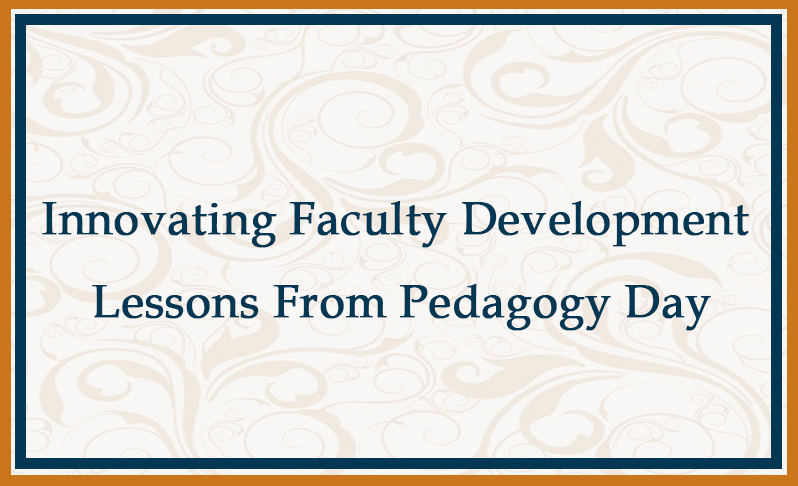By far our most important innovation for faculty development at Eastern Kentucky University (EKU) has been Pedagogy Day. Our last post discussed innovating New Faculty Orientation (NFO) in general, but this post will concentrate on the opening day of New Faculty Development.
Remember that old Head and Shoulders TV commercial with the tagline “You never get a second chance to make a first impression”? What first impression do you want to make on your new faculty? Perhaps as an R1 institution, you want to stress the importance of scholarship. Our university is an historic teachers college with a 4-4 teaching load wherein the emphasis has always been on teaching. Therefore, we created a poster that reads EXCELLENCE IN TEACHING IS JOB ONE, which we also use on our website, and, appropriately, we label day one of NFO as Pedagogy Day.
Related Reading: 3 Principles for Innovating The Faculty Development Experience
Space Matters
We are great believers in Marshall McLuhan’s dictum that “The medium is the message,” so the space in which we hold NFO tells our audience as much as our words. When we first took over the program, NFO was held in an ornate lecture hall with the newbies lined up in rows and columns; the talking heads sat at tables in front of the room and talked from behind a podium. What was the special message if not that learning best occurred in a lecture format? Unfortunately, at the current stage of our faculty development evolution, active learning had been the dominant pedagogy for 15 years, but the space did not reflect that notion.
So one of our first steps was to transition NFO from the lecture hall to the wide open spaces of our Noel Studio for Academic Creativity. The Discovery Classroom consists of a large room with two-floor high ceilings complete with skylights that admit volumes of sunlight. Instead of rows and columns, the room contains tables on wheels and movable chairs. Interspersed through the room are smartboards, flip charts, computers, and monitors. The wall has been painted bright colors on which hang contemporary art pieces. A spiral staircase that seems a wooden representation of the DNA structure leads to the next floor. As we detail in Teaching Applied Creative Thinking (2013), brighter spaces produce deeper thinking students, and brighter spaces are created by four elements:
- Natural light
- Bright colors
- Flexible and comfortable furniture
- Writable spaces (23-4).
Instructor Placement
If our students—i.e., new professors—have these tools geared toward active learning, where do we place the instructors? Years ago at the Lilly Conference on Teaching & Learning at Miami we met Erica McWilliams, bought her The Creative Workforce, and bought into her theory in effective instructors being meddlers from the middle. In the aforementioned Teaching Applied Creative Thinking we modified her approach to what we call the mentor from the middle. As we said, “The Mentor-from-the-Middle, as a new paradigm for teaching, calls on the instructor to assume several roles: facilitator, coach, artist, critical reflector, model, and scholar” (60).
And do it all from the middle of the room. We also reasoned that if one mentor is good, why not use more, so now on Pedagogy Day the three of us begin in the middle of the Discovery Classroom, and throughout the two-plus hours we circulate throughout the crowd. Not only do we make eye contact, but we constantly touch upon the participants’ 18-inch-imaginary cylinder around them. In short, they invaded our physical space and now we invade their psychological space.
On a theoretical level, having three co-instructors sends a powerful message about collaboration (one of our creative thinking strategies) in teaching, something we did for over thirty-five years. On a practical level, while we have a “script” for Pedagogy Day, so much of what we do is piggybacking (another of our creative thinking strategies) off of each other’s comment as well as those of our newbies. The resulting spontaneity creates a remarkable flow (still another of our creative thinking strategies).
Related Reading: Why Successful Faculty Development Requires Innovation
Obviously, through our use of space and our instructional methodology, we are modeling key teaching strategies. No matter what we say to them, we have found through post-NFO surveys what they most remember is what we do.
Next time we’ll go into what we actually tell the new faculty.
Author
 Ph.D Hal Blythe writes literary criticism to mystery stories. In addition to the eleven books he’s published with New Forums, Hal has collaborated on four books on a variety of subjects, over 1000 pieces of fiction/nonfiction, and a host of television scripts and interactive mysteries performed by their repertory company. He is currently co-director of the Teaching and Learning Center for Eastern Kentucky University. Meet Hal Blythe.
Ph.D Hal Blythe writes literary criticism to mystery stories. In addition to the eleven books he’s published with New Forums, Hal has collaborated on four books on a variety of subjects, over 1000 pieces of fiction/nonfiction, and a host of television scripts and interactive mysteries performed by their repertory company. He is currently co-director of the Teaching and Learning Center for Eastern Kentucky University. Meet Hal Blythe.



